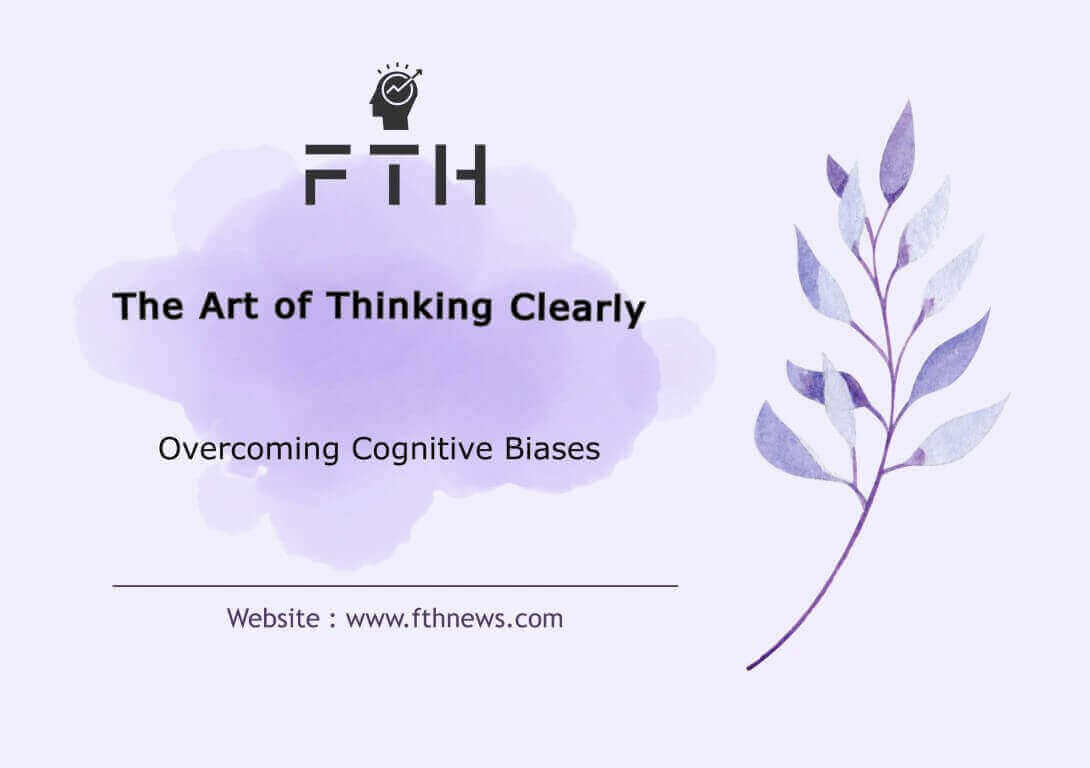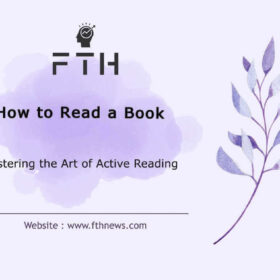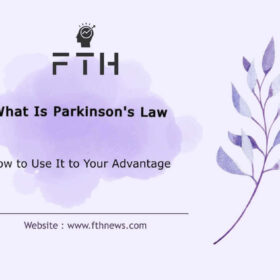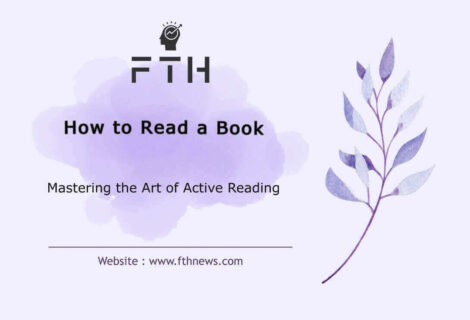
Have you ever found yourself buying something you didn’t need just because the salesperson was friendly? Or felt overwhelmed when faced with too many options? These common experiences highlight our susceptibility to cognitive biases—mental shortcuts that can lead us astray. Understanding these biases can help us think more clearly and make better choices. Ralph Dobelli’s book, The Art of Thinking Clearly, explores these biases and offers strategies to avoid them.
The Art of Thinking Clearly:
Many of us fall into the trap of flawed thinking without realizing it. Cognitive biases subtly influence our decisions, often leading us to make choices that are not in our best interest. Consider a time when you bought something unnecessary. Maybe the salesperson was persuasive, or you simply wanted to fit in. These situations showcase common cognitive biases.
For instance, buying an overpriced gadget just because it’s popular is an example of social proof. This bias leads us to follow the actions of others, assuming they know better, even when we lack sufficient information ourselves. Social proof can drive us to make purchases based on trends rather than our actual needs.
Another example is the sunk cost fallacy, where we continue investing in something because we have already invested so much, even when it’s no longer beneficial. For example, not walking away from a bad investment because of the money already spent is a manifestation of this bias. This fallacy stems from our desire to avoid loss and our irrational attachment to past investments, leading us to make decisions based on previous costs rather than future benefits.
Recognizing these patterns is the first step towards understanding why we make certain decisions. By being aware of these biases, we can develop strategies to counteract them, leading to more rational and informed choices. Identifying cognitive biases in our thinking helps us break free from flawed decision-making processes and adopt a clearer, more logical approach to our everyday choices.
Overview of “The Art of Thinking Clearly”
The Art of Thinking Clearly by Rolf Dobelli aims to help readers identify and avoid cognitive biases that distort our thinking. Dobelli, drawing on years of research and insights from psychology, behavioral economics, and neuroscience, explains how these biases impact our decisions and offers practical advice to overcome them. The book covers a wide array of themes, including social proof, sunk costs, and the paradox of choice, among others.
Key Themes Explored:
- Social Proof: Dobelli delves into how our decisions are influenced by the actions of others. He illustrates how we often follow the crowd, assuming the majority must be correct, and provides strategies to counter this tendency.
- Sunk Costs: The book explains how the sunk cost fallacy leads us to irrationally continue investments based on past expenditures rather than future gains. Dobelli offers techniques to recognize and avoid this common pitfall.
- Paradox of Choice: Dobelli addresses the modern dilemma of having too many options and how it can paralyze decision-making. He provides insights into simplifying choices to reduce anxiety and improve satisfaction with our decisions.
- Reciprocity, Envy, and Other Biases: The book also explores other cognitive biases such as reciprocity, where we feel compelled to return favors, and envy, which drives us to desire what others have. Dobelli’s explanations help readers understand the underlying mechanisms of these biases and how to mitigate their effects.
By understanding these concepts, readers can improve their decision-making skills. Dobelli’s clear and engaging writing style makes complex psychological concepts accessible and applicable to everyday life. Each chapter is dedicated to a specific bias, providing real-life examples and practical tips to help readers think more rationally and make better choices.
In summary, The Art of Thinking Clearly serves as a comprehensive guide to recognizing and overcoming the cognitive biases that cloud our judgment, empowering readers to make more informed and effective decisions in both personal and professional contexts.
Cognitive Biases and Mental Shortcuts
Cognitive biases are mental shortcuts, or heuristics, that help us process information quickly and make decisions more efficiently. While these shortcuts can be beneficial in some situations, they often lead to errors in judgment, causing us to make flawed decisions.
Benefits of Cognitive Biases:
- Speed Up Decision-Making: In situations requiring quick decisions, cognitive biases allow us to act swiftly without extensive analysis.
- Simplify Complex Information: By relying on mental shortcuts, we can navigate complex information and make sense of our environment more easily.
Drawbacks of Cognitive Biases:
- Lead to Flawed Decisions: These shortcuts often cause us to overlook critical information, leading to poor choices.
- Cause Irrational Behavior: Biases can result in irrational actions that are not in our best interest, driven by factors like emotion or social influence.
Let’s explore specific cognitive biases in detail.
The Art of Thinking Clearly: The Black Swan
For centuries, people believed all swans were white. This belief was overturned in 1697 when black swans were discovered in Australia. The term “black swan” now symbolizes rare, unpredictable events with significant impact.
Examples of Black Swan Events:
- Positive: Career breakthroughs, discovering a gold mine
- Negative: Market crashes, natural disasters
Understanding black swans is crucial because they can dramatically alter our lives. While we cannot predict these events, we can prepare for them by saving money, staying out of debt, and investing cautiously. Recognizing the possibility of black swan events encourages us to build resilience and flexibility into our plans.
By learning about cognitive biases and their impacts, we can better navigate the complexities of our world. This awareness helps us mitigate the negative effects of biases and make more informed, rational decisions.
The Art of Thinking Clearly: Social Proof
Social proof occurs when we mimic the behavior of others, assuming it is correct. This phenomenon is based on the idea that if many people are doing something, it must be the right thing to do. Imagine you’re walking to a concert and see a crowd looking up at the sky. Naturally, you look up too. This is social proof at work.
Everyday Examples:
- Clapping in a concert because others do: You might start clapping at the end of a performance simply because the audience around you is clapping, regardless of your own opinion of the performance.
- Tipping staff because everyone else does: In a restaurant, you might feel compelled to leave a tip if you see others doing so, even if the service was mediocre.
Social proof is deeply rooted in our evolutionary history. For our ancestors, following the group was a survival strategy. If a group of people ran away from a threat, it was safer to follow rather than stay and investigate. However, in modern times, this instinct can lead to poor decisions, such as panic buying stocks during a market surge or following harmful trends just because they are popular.
Solomon Asch’s Experiment: In the 1950s, psychologist Solomon Asch conducted an experiment to demonstrate how peer pressure distorts common sense. Participants were asked to match line lengths, and actors intentionally chose incorrect answers. When influenced by these actors, participants chose incorrect answers 33% of the time. This experiment highlights the profound impact of social proof on our decisions, showing that the desire to conform can override our own perceptions and judgments.
The Art of Thinking Clearly: Sunk Cost Fallacy
The sunk cost fallacy occurs when we continue investing in something because we’ve already invested so much, even when it’s no longer beneficial. This bias is driven by the emotional difficulty of admitting a loss and the desire to justify past decisions.
Real-Life Examples:
- Watching a boring movie because you paid for the ticket: You might stay through a tedious movie because you don’t want to feel like you wasted the money spent on the ticket.
- Sticking with a failing advertising campaign: A business might continue pouring money into an ineffective marketing campaign because of the substantial amount already invested, despite clear signs that it’s not yielding results.
Psychologically, admitting a mistake and cutting losses is hard. The emotional attachment to past investments makes it challenging to abandon them. However, focusing on potential future losses rather than past investments can help avoid this fallacy. Shifting our perspective to consider the future benefits of our choices rather than past expenditures allows for more rational decision-making. Recognizing when to cut losses and move on is a valuable skill that can prevent further waste of resources and lead to better outcomes.
The Art of Thinking Clearly: Reciprocity
Reciprocity is the principle of mutual exchange. It’s a social norm that suggests if someone gives us something or does us a favor, we feel compelled to return the gesture. This principle is deeply embedded in human psychology and social interactions, fostering cooperation and building relationships.
Real-World Examples:
- Religious sects giving flowers at airports, then asking for donations: This tactic leverages reciprocity by creating a sense of obligation in the recipient to give something in return for the unexpected gift.
- Charity organizations sending gifts to encourage donations: Many charities send small gifts, such as address labels or calendars, in their fundraising appeals. This gesture makes recipients feel obliged to reciprocate by making a donation.
Reciprocity has evolutionary roots, promoting cooperation and social bonding, which were crucial for the survival of early human communities. However, this principle can be manipulated in modern times. Marketers and salespeople often exploit reciprocity to influence our decisions. Being aware of this tactic helps us recognize when free offers and favors might come with strings attached, allowing us to make more conscious and deliberate choices.
The Art of Thinking Clearly: Envy
Envy is a common emotion where we desire something someone else has. It differs from jealousy, which involves the fear of losing something we already possess. Envy can be a powerful motivator but often leads to negative feelings and behaviors.
Examples Illustrating Envy:
- Financial envy among colleagues: Seeing a coworker receive a higher salary or a promotion can trigger envy, leading to dissatisfaction and potential workplace conflict.
- Social envy among friends: Observing a friend’s seemingly perfect life on social media can stir feelings of envy, making us feel inadequate or unhappy with our own lives.
Envy can lead to irrational behavior and unhappiness. To control envy, it’s essential to avoid comparing yourself to others and focus on self-improvement. Practicing gratitude for what you have and setting personal goals can help redirect the energy spent on envy toward positive growth. Remember, the person you should envy is the one you aspire to become. This mindset fosters a healthier approach to personal development and satisfaction.
In summary, understanding reciprocity and envy helps us navigate social interactions more mindfully. By recognizing the influences of these emotions and principles, we can make more conscious decisions and cultivate a more fulfilling and rational approach to life.
The Art of Thinking Clearly: The Paradox of Choice
In today’s world, we face an overwhelming number of choices in virtually every aspect of our lives. While having options is often seen as a sign of progress and freedom, too many choices can paralyze us, leading to poor decisions or decision fatigue.
Real-World Examples:
- Supermarkets with too many varieties: The cereal aisle, for example, can present hundreds of options, making it difficult for consumers to choose one product. This abundance can lead to frustration and indecision.
- Online dating with countless potential partners: The seemingly endless options on dating apps can make it challenging to commit to one person, fostering a “grass is always greener” mentality.
Barry Schwarz’s Explanation: Psychologist Barry Schwarz, in his book The Paradox of Choice: Why More Is Less, explains that too many options can overwhelm and numb the mind. In one experiment, participants who were presented with fewer types of jelly were more likely to make a purchase than those who were offered a wide variety. Schwarz argues that reducing the number of choices can alleviate the burden of decision-making and increase satisfaction with our choices. To tackle choice overload, he suggests simplifying decision criteria and accepting that no choice is perfect, which can help us make decisions more efficiently and with greater contentment.
The Art of Thinking Clearly: Chauffeur Knowledge
Chauffeur knowledge refers to superficial understanding that is memorized or repeated to impress others, rather than true, deep knowledge gained from experience and expertise. This type of knowledge is often used to appear knowledgeable without a genuine understanding of the subject.
Real-World Examples:
- News anchors reading scripts: Anchors may sound authoritative on various topics, but they often rely on scripts written by others and may not have a deep understanding of the content they present.
- Journalists writing based on Google searches: Some journalists compile articles using readily available information from the internet without extensive research or firsthand experience, leading to shallow reporting.
The key difference between true experts and charlatans is that experts acknowledge their limits and are open to learning more. They have a depth of knowledge gained from study and experience, whereas charlatans rely on rehearsed information to give the appearance of expertise. Being cautious of those who never admit they don’t know something can help us discern genuine knowledge from superficial understanding.
In conclusion, understanding the paradox of choice and the distinction between chauffeur knowledge and true expertise can improve our decision-making processes and help us identify reliable sources of information. By simplifying our choices and seeking authentic knowledge, we can navigate life’s complexities more effectively and make better-informed decisions.
Liking Bias
Liking bias means we are more likely to buy from, agree with, or help people we like. This cognitive bias significantly influences our decisions and behavior, often without us realizing it.
Examples of Liking Bias:
- Sales techniques involving compliments: Salespeople often use flattery and build rapport to create a favorable impression, making us more inclined to buy from them.
- Multi-level marketing using home parties: These gatherings leverage personal relationships and social interactions to encourage sales, capitalizing on the trust and affection among friends.
- Non-profit campaigns featuring appealing images: Charities often use images of attractive or endearing individuals in their marketing materials to evoke positive emotions and increase donations.
Advertisements and sales agents often exploit this bias. It’s crucial to evaluate products and offers based on their merits rather than the likability of the person presenting them. Being aware of the liking bias can help us make more rational and objective decisions.
Application of Cognitive Biases in Personal Life
Identifying and understanding our personal cognitive biases is key to making better decisions. Awareness of these biases can help us recognize when we are being influenced irrationally and take steps to counteract these effects.
Practical Tips:
- Take time before making choices: Avoid rushing into decisions. Give yourself the opportunity to think things through and consider all factors.
- Seek diverse perspectives: Consult different viewpoints and opinions to broaden your understanding and reduce the influence of any single bias.
- Commit to continual learning: Stay informed and educate yourself about common cognitive biases and their impact on decision-making. This knowledge can empower you to make more rational choices.
Self-awareness is critical. Recognize when you’re falling into a cognitive trap and take proactive steps to avoid it. By being mindful of cognitive biases, you can improve your decision-making processes and lead a more balanced and informed life.
In conclusion, understanding and managing cognitive biases, such as liking bias, is essential for making better decisions both personally and professionally. By implementing practical strategies to mitigate these biases, we can enhance our judgment and achieve more rational outcomes.
Utilizing Knowledge of Cognitive Biases in Career and Organizations
In professional settings, understanding cognitive biases can significantly enhance decision-making, team performance, and overall organizational effectiveness. Recognizing these biases helps professionals and leaders make more rational choices, fostering a culture of critical thinking and continuous improvement.
Strategies:
- Encourage Rational Thinking: Promote a culture where rational and evidence-based decision-making is valued. Encourage employees to question assumptions and consider multiple perspectives before reaching conclusions.
- Improve Organizational Decisions by Considering Biases: Implement processes that account for common biases. For example, use structured decision-making frameworks that help mitigate the influence of individual biases.
- Foster an Environment of Continuous Improvement: Create an organizational culture that prioritizes learning and development. Encourage feedback, reflection, and ongoing education to help employees recognize and overcome their biases.
Avoiding Cognitive Errors
Cognitive errors can cloud our judgment, leading to suboptimal decisions. To think clearly and make better decisions, it’s crucial to adopt strategies that help mitigate the influence of these biases.
General Strategies:
- Take Your Time Before Deciding: Avoid making hasty decisions. Allowing time for reflection helps ensure that all relevant information and perspectives are considered.
- Seek Diverse Opinions: Consult with colleagues, mentors, and external experts to gather a wide range of viewpoints. This reduces the risk of groupthink and broadens your understanding of the issue at hand.
- Keep Learning and Staying Informed: Continually educate yourself about cognitive biases and their impact on decision-making. Stay informed about best practices in your field to enhance your judgment and knowledge base.
Enhancing Decision-Making Skills
Logical and informed decisions are key to success in both personal and professional life. Developing robust decision-making skills involves using various tools and techniques to ensure comprehensive and unbiased evaluations.
Tools and Techniques:
- Use Decision Matrices: Employ decision matrices to systematically evaluate and compare different options based on a set of criteria. This helps prioritize factors objectively and reduces the impact of personal biases.
- Conduct Pros and Cons Analyses: List the advantages and disadvantages of each option to gain a balanced view of potential outcomes. This encourages thorough consideration of all aspects of the decision.
- Stay Mindful of Biases: Regularly remind yourself and your team of common cognitive biases. Implement checks and balances, such as peer reviews, to identify and address biased thinking.
Continual Improvement and Awareness
Continual improvement and awareness are essential for better decision-making over time. By regularly reflecting on past decisions and learning from mistakes, individuals and organizations can refine their processes and enhance their judgment.
In summary, understanding and mitigating cognitive biases in professional settings can lead to more rational decision-making and improved organizational performance. By fostering a culture of continuous learning and critical thinking, individuals and teams can make more informed and effective choices, leading to sustained success.
Conclusion The Art of Thinking Clearly:
In the journey through The Art of Thinking Clearly, we’ve learned about cognitive biases that impact our thinking. From the unpredictability of black swan events to the pitfalls of the sunk cost fallacy, understanding these biases helps us navigate life’s complexities more effectively. Awareness and understanding are the first steps toward making more rational and informed decisions—protecting us from the troubles and irrational thoughts we often create ourselves.
For more insights, explore other content that delves into various cognitive biases and mental shortcuts, helping you lead a more rational life.














